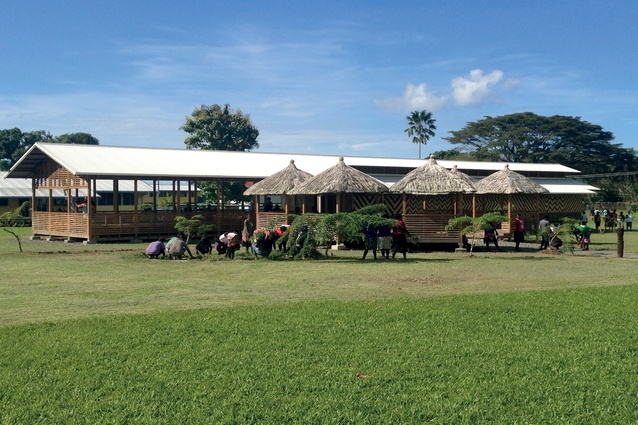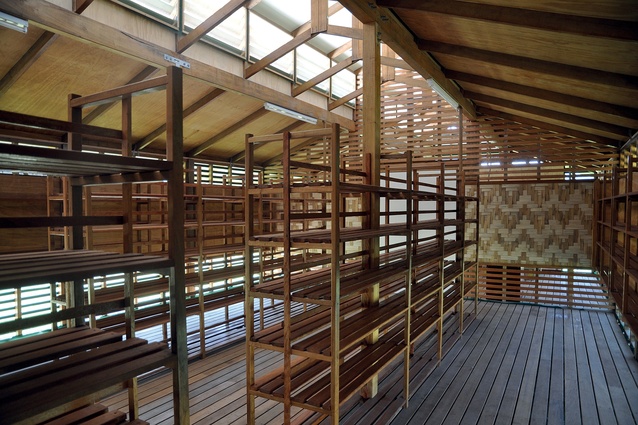Bougainville mon amour
Inspired by the film Mr. Pip, the people of Wellington funded a new library for the people on the island of Bougainville, a province of Papua New Guinea. Guy Marriage attended a talk given by the library’s architect, Paul Kerr-Hislop of Art + Architecture, as part of the City Talks series, organised jointly by NZIA Wellington branch and City Gallery Wellington.
For those lovers of architectural palimpsest, the Bougainville Library is a many-layered thing: a talk, about a project, for a library, springing from a book, about a reading from another book, on an exotic Pacific Island far away from what we think of as civilisation and, yet, funded by the people of Wellington, because they liked what they saw in a film.
The project is an intoxicating combination of Charles Dickens’ Great Expectations, Lloyd Jones’ novel Mister Pip, Andrew Adamson’s film Mr. Pip and Hugh Laurie’s Mr Watts, along with a gorgeous Pacific Island of heart-breaking poverty and Paul Kerr-Hislop’s beautifully simple response to the brief: design a library.

Kerr-Hislop (of Art + Architecture) is becoming used to talking about the Bougainville Library project but his audiences never tire of hearing about it. On 20 April, he presented the project, from the inception right through to completion, at City Talks in Wellington. However, he could not even get to site to see this project until prior to completion. The presentation was, on the one hand, a simple talk about a simple building and, yet, like the building itself, there were many strands of local input woven in.
Simple concepts, such as deep eaves, low-tech materials and rooftop ventilation, were explained but, overall, the project has a pretty simple plan – books down one end and people reading books up the other end. Kerr-Hislop’s concepts and drawings were completed in Wellington but the project’s timely completion owes as much to the contractor Barry Binding, an endearingly lovely shaggy-haired bloke who was training up young furniture apprentices in Bougainville. New Zealand needs more Barry Bindings in Bougainville!
We were fortunate to have Barry Binding in the audience to hear Kerr-Hislop’s talk, along with several other VSA (Volunteer Service Abroad) members who were involved with the project, such as James Koibo from the Bougainville Library Trust.
By all accounts, the locals have taken the library to heart and, indeed, the external appearance of the building is wrapped in their local weaving prowess: an organic, geometric layer of cladding that protects the precious cargo of books from the sun and the humidity.
Kerr-Hislop’s talk was about the delight he felt in reaching the site – eventually – after rafting across islands on banana boats and driving across battered roads to Arawa, the capital of Bougainville, where conditions are embarrassingly destitute. The building looks delightful (most of the pre-existing buildings were destroyed in the wars for independence during the 1970s, 1980s and 1990s) and, sadly, it seems to be pretty much the only decent building they have; most people live in poor conditions and, yet, as inevitably seems to happen, the children appear smiling and happy as the wars are now over.

The opening ceremony (Kerr-Hislop had several clips of hand-held, homespun footage) involved traditional Papua New Guinea/Solomon Islands dancing and singing, refreshingly met by an equally confronting haka put on by Lloyd Jones, Kerr-Hislop and others, including (thankfully) some of the local New Zealand police, who put some hearty invigoration into the otherwise scrawny pakeha line-up. The locals loved it!
The City Talks session (organised jointly by NZIA Wellington branch and City Gallery Wellington) was unusually full of non-architects – at last, the profession coming face to face with the public, instead of speaking at cross-purposes across a wide chasm. Questions after the talk centred around issues such as “what should we do now?”, to which the answer seems most definitely to be “keep giving to VSA as it is doing good works abroad”. We need more feel-good projects – it’s even better if the locals truly appreciate them too – and, with this one, they certainly do.
Last word should, of course, go to the users of the library and Kerr-Hislop showed us refreshing evidence of the adaptability of the architecture to cater for the clients. All the walls and floors are breathable – literally – to let the cool air wash through, and carefully screened with a bug-proof mesh to stop the tomes being eaten (Wellington provided VSA with the books as well) and to stop any build-up of humidity and moisture. What delighted Kerr-Hislop, and the audience as well, was the sight of a group of children huddled under the shelving, bodies cooling in the filtered natural breeze and deeply engrossed in the printed word. Now that’s a real education.
A lovely, lovely building and a project that, perhaps, comes along only once in an architect’s lifetime. Unless we want to change that destiny and go and volunteer with VSA ourselves…?












